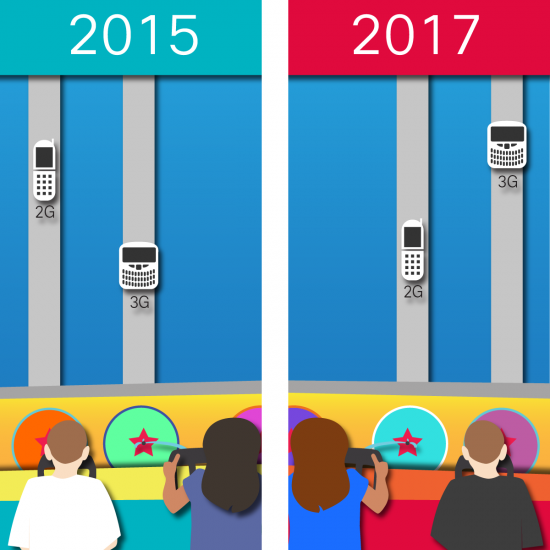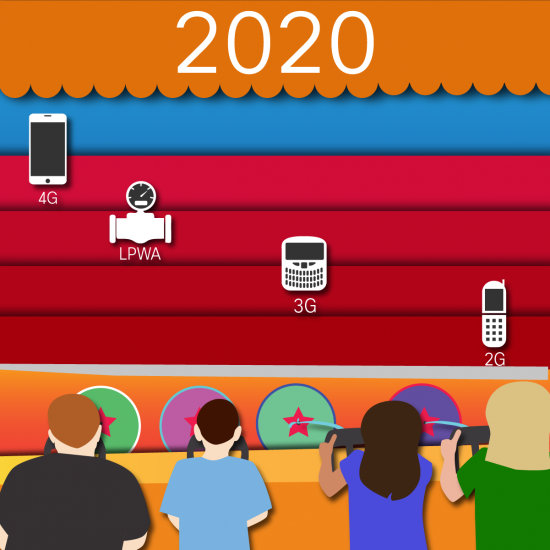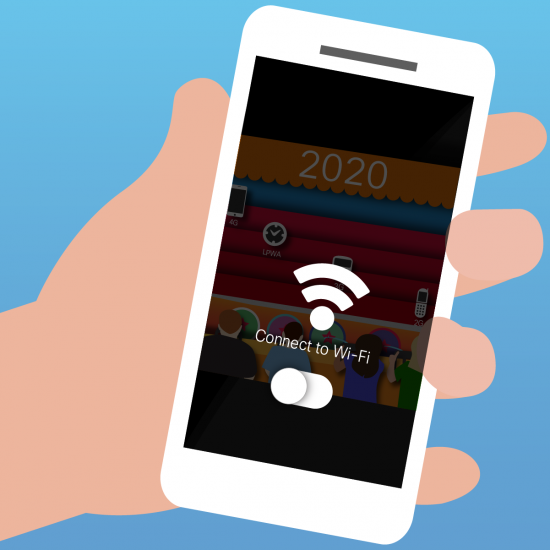Every time a new generation of mobile network has been introduced – 2G networks transitioning to 3G, and 3G evolving to 4G, there have been concerns about the user adoption and capacity utilization. And each time skeptics have been proven wrong.
By 2020, smartphones will represent 48.1% of global mobile-connected devices in use, and generate 80.8% of total global mobile data traffic. Within that same time frame, 4G capable devices and connections will gain the highest share (40.5%) of all mobile devices and connections.
Mobile network evolution is driven by devices that are getting smarter and conversations around future 5G deployments have already begun in technology circles. Now two weeks since the release of the 2016 VNI Mobile Forecast, step right up and come inside the “Carnival of Mobile Connections” for an up close and personal look at just how far the mobile network has come.

2G today, 3G by 2017
2G was the first digital network technology introduced in the 1980s, which brought to us the basic data services such as texting in addition to voice. And even though 2G technology may seem like “old man river”– it’s actually still the leader when it comes to global mobile communications.
Even though digitization is fueling enhanced network and device capabilities; the connectivity for 52% of mobile devices and connections in 2015 was still supported by 2G. The bandwidth and latency it offers are still suitable for basic feature handsets (nonsmartphones), which accounted for 51% of all devices and connections in 2015. Globally, the relative share of 3G- and 3.5G-capable devices and connections will surpass 2G-capable devices and connections by 2017. The relative share of 2G and 3G by 2017 is expected to be 36% and 38% respectively.
In other words 2G is still a solid bet–and the only game in town–for many (particularly in emerging markets).

By 2020, 4G takes the lead
In 2020, more carnival-goers jumping in the mobile network game will cause a significant crossover as 40.5% of all global devices and connections will be 4G-capable. The global mobile 4G connections will grow from 1.1 billion in 2015 to 4.7 billion by 2020, more than 4-fold growth.
To keep pace with the growth of mobile applications, the adoption of mobile connectivity and the need for optimized bandwidth management and network monetization, service providers will roll out 4G networks to meet the growing demand users have for more bandwidth, higher security, and faster connectivity on the move. Now, everyone can post videos and pictures of their carnival experiences. Service providers and their partners can add application enhancements that show users where their favorite games are, and let them know about the exciting prizes they can win (location-based services)—all without overloading the network.

LPWA gains M2M share by 2020
The Low-Power Wide-Area (LPWA) network is an ultra-narrowband wireless network solution meant specifically for machine-to-machine (M2M) applications that require low bandwidth and campus-like coverage. So for this leg of the mobile race, network connectivity for end-user devices such as phones and tablets are not included.
LPWA provides high coverage with low power consumption, module, and connectivity costs, creating new machine-to-machine (M2M) use cases for mobile network operators (MNOs) that couldn’t have been addressed by cellular networks alone. This includes meters in residential basements, gas or water meters with no power connections, street lights, and asset trackers.
LPWA connection shares (all M2M) will grow from 4% in 2015 to 28% by 2020, from 21.6 million in 2015 to 859 million by 2020.

Wi-Fi offload traffic grows through 2020
If you happen to have issues connecting to mobile carnival sites and apps via a cellular network, there’s good news—Wi-Fi. Thanks to the dual-mode (cell and Wi-Fi) capability of virtually every mobile device (e.g., smartphones, tablets, et al.) and the widespread availability of Wi-Fi networks in many public venues, you can almost always stay connected to your favorite online resources.
In 2015, more than half (51%) of mobile traffic was offloaded and by 2020 this ratio is going to increase to 55%. Offload traffic comes from dual-mode devices onto Wi-Fi/small cell networks. Wi-Fi offload continues to be relevant, even for 3G and 4G networks, due to growing pressures from data cap pricing models that can be impacted by higher multi-media/video usage as well as mobile gaming.
Conclusion
Mentioned earlier, 5G appears to be the next phase of technology that will provide higher bandwidth and lower latencies than 4G, driven by growing digitization. Though not expected until 2020, 5G deployments are set to be the next game-changing moves in an ever-changing mobile network evolution.
To learn more about the key findings and projections from this year’s VNI Mobile Forecast, check out the Cisco VNI Forecast Homepage, the Cisco VNI Mobile Forecast Report and the Cisco VNI Mobile Forecast Highlights Tool for global, regional, and country-level information.
Register to attend the VNI Global Mobile Data Traffic Forecast webcast on Tuesday, February 23.

Dear Cisco,
What about: Photon Chips Technology?? Can u tell u, more about this Technology .. Shall this change also, our Mobile Phones more faster Speed??
Br
James Zhou from Hesjamar V@platforms
Thanks James Zhou for your interest and comments on the blog. As part of Cisco VNI forecast we haven¹t looked at the contributions of photon chip technology in reference to mobile networks evolution in particular – our focus being primarily on the access networks. To the extent the technology enables and enhances mobile network capabilities and capacities from the access perspective we would capture it in our forecast. If you have further interest we can put you in touch with our subject matter expert on that topic.
Watching this evolve from the analog days is so refreshing. The need for speed is here. There is still plenty of room for this technology in our counties
Thank you, this is great news to hear! Thank you, for your forward thinking and observations that you put to action.
Thanks Carolyn Tarr for your interest and comments on the blog. We are all experiencing an exciting growth of network connectivity and mobile networks, in particular, globally.